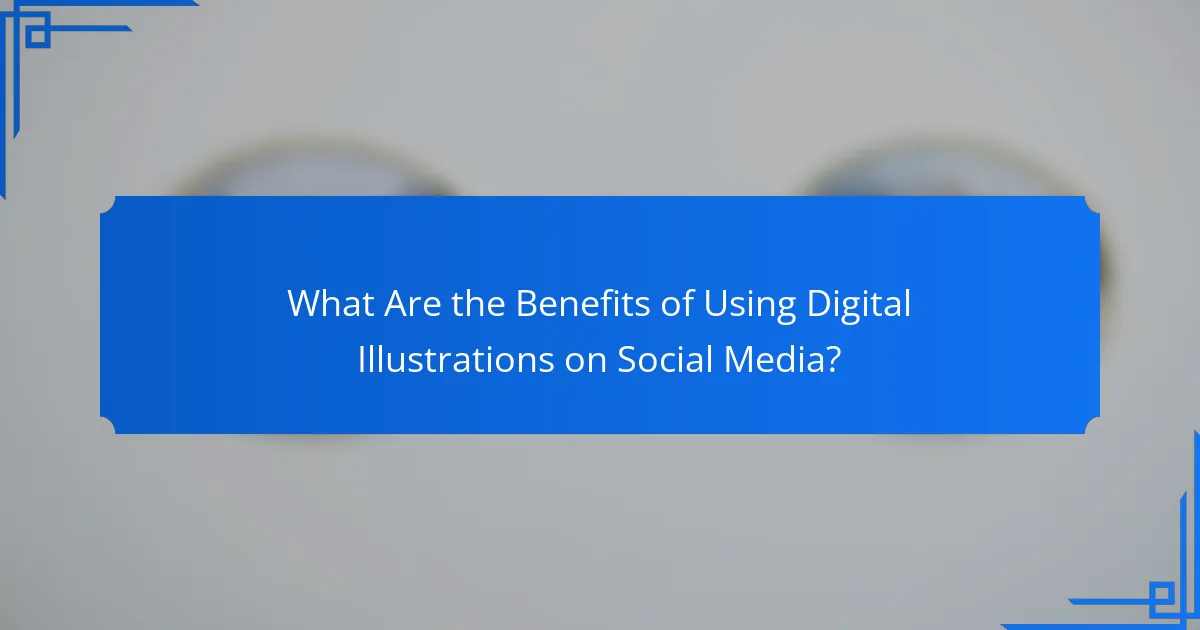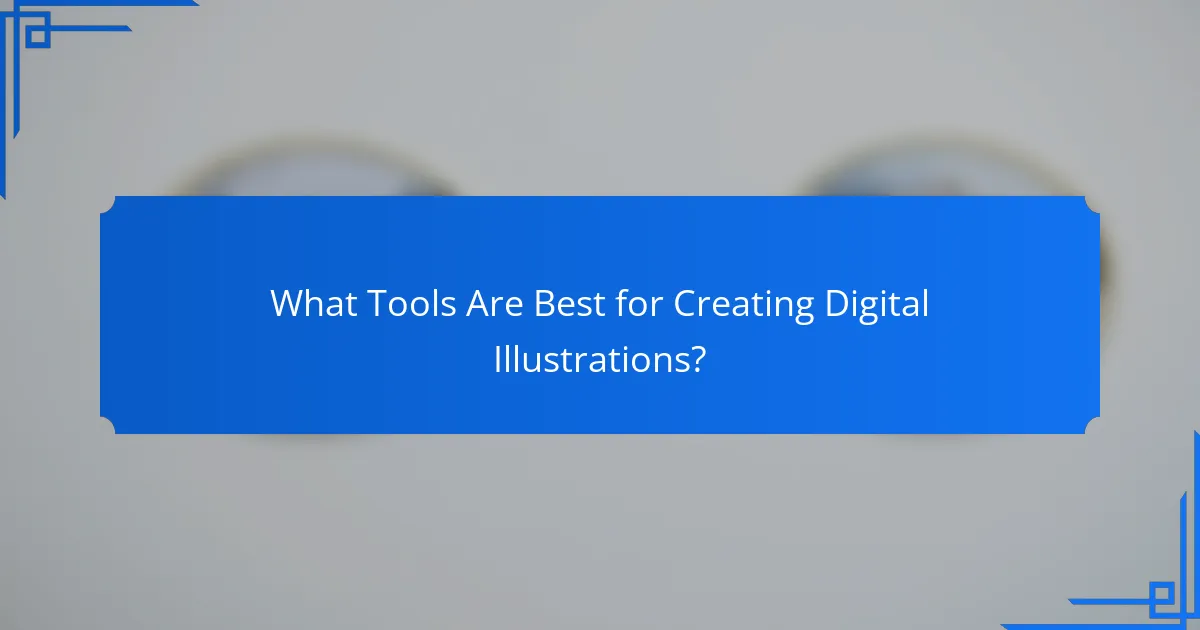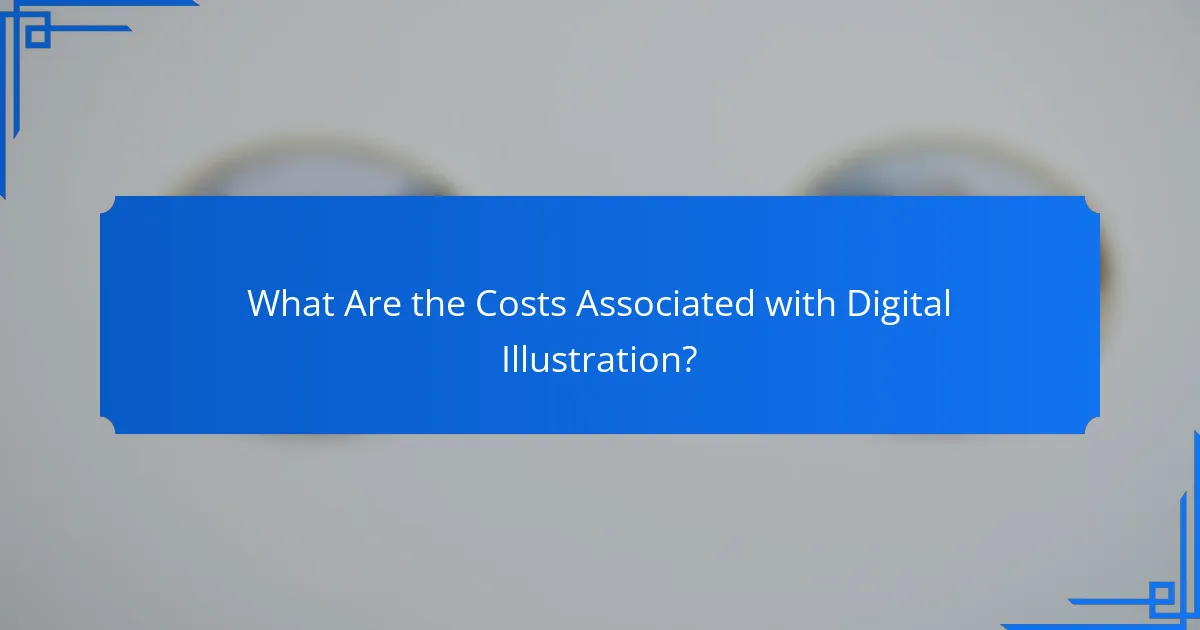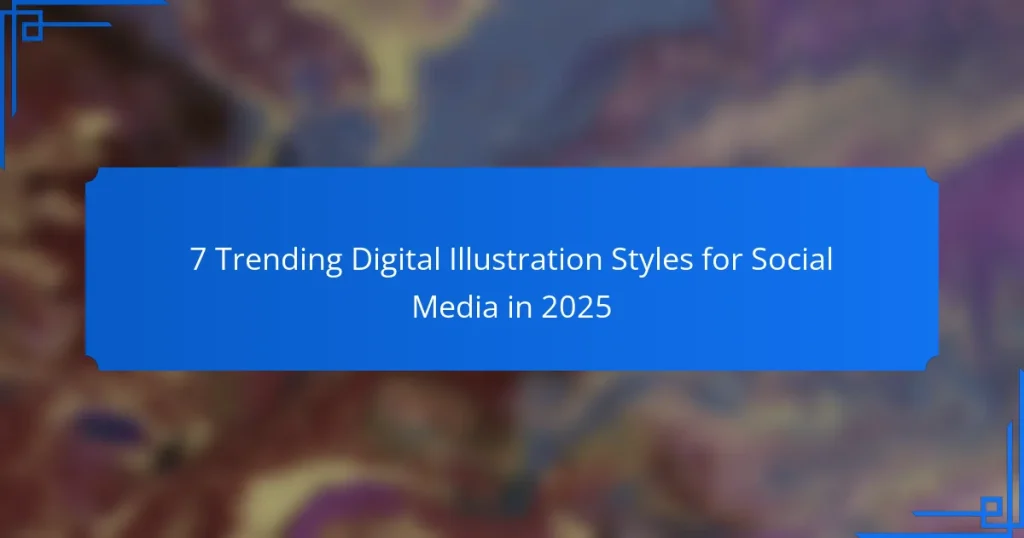As we move into 2025, digital illustration styles are evolving to create more engaging visuals for social media platforms. Trends such as 3D illustrations, minimalist designs, and retro aesthetics are becoming essential tools for brands to capture attention and convey their messages effectively. By aligning these styles with brand identity and audience preferences, businesses can enhance their social media presence and stand out in a competitive landscape.

What Are the Top Digital Illustration Styles for Social Media in 2025?
In 2025, the leading digital illustration styles for social media focus on engaging visuals that resonate with audiences. Key trends include 3D illustrations, minimalist designs, retro aesthetics, hand-drawn elements, and dynamic typography, each offering unique ways to capture attention and convey messages effectively.
3D Illustrations
3D illustrations are becoming increasingly popular for their ability to create depth and realism in digital content. These visuals often utilize advanced rendering techniques to produce striking images that can enhance brand storytelling. Consider using 3D elements to showcase products or create immersive experiences that draw viewers in.
When incorporating 3D illustrations, ensure they align with your brand’s identity and message. Overly complex designs can distract from the core message, so aim for a balance between detail and clarity. Tools like Blender or Cinema 4D can help create professional-quality 3D graphics.
Minimalist Designs
Minimalist designs emphasize simplicity and clarity, making them effective for social media where attention spans are short. This style often features clean lines, ample white space, and a limited color palette, allowing the message to stand out without distractions. Brands can leverage minimalism to convey sophistication and modernity.
To implement minimalist designs, focus on essential elements and avoid clutter. Use bold typography and simple icons to communicate ideas quickly. This approach can be particularly effective in platforms like Instagram or Twitter, where visual impact is crucial.
Retro Aesthetics
Retro aesthetics draw inspiration from past design trends, evoking nostalgia and familiarity. This style can include vintage color schemes, typography, and graphic elements reminiscent of the 70s, 80s, or 90s. Brands can use retro designs to create a sense of authenticity and connect with audiences on an emotional level.
When adopting retro aesthetics, consider the cultural context and ensure it aligns with your target audience’s preferences. Mixing modern elements with vintage styles can create a fresh yet familiar look that resonates well on platforms like Facebook and Pinterest.
Hand-Drawn Elements
Hand-drawn elements add a personal touch to digital illustrations, making them feel more relatable and approachable. This style can include sketches, doodles, or watercolor effects, which can humanize a brand and foster a connection with the audience. Hand-drawn visuals are particularly effective for storytelling and conveying authenticity.
To incorporate hand-drawn elements, consider using tools like Procreate or Adobe Fresco, which allow for easy creation of custom illustrations. Ensure that these elements complement your overall design and do not overwhelm the main message.
Dynamic Typography
Dynamic typography involves the creative use of text in illustrations, making it a powerful tool for grabbing attention. This style can include animated text, varying font sizes, and bold color contrasts to emphasize key messages. Dynamic typography can enhance engagement and make posts more memorable.
When using dynamic typography, ensure readability remains a priority. Experiment with different fonts and layouts, but avoid overly complex designs that may confuse viewers. Platforms like TikTok and Instagram Stories are ideal for showcasing this style, as they allow for creative text presentation.

How to Choose the Right Style for Your Brand?
Choosing the right digital illustration style for your brand involves aligning with your brand identity, understanding your target audience, and staying current with design trends. Each of these factors plays a crucial role in ensuring your visuals resonate effectively with your audience and reflect your brand’s values.
Align with Brand Identity
Your brand identity encompasses your values, mission, and personality. Select an illustration style that embodies these elements; for instance, a playful brand may benefit from vibrant, cartoonish illustrations, while a luxury brand might prefer sleek, minimalist designs.
Consider creating a mood board that combines colors, typography, and imagery that represent your brand. This visual reference can help you identify which illustration styles align best with your overall brand aesthetic.
Consider Target Audience Preferences
Understanding your target audience is essential when choosing an illustration style. Conduct surveys or analyze social media engagement to determine which styles resonate with your audience demographics. For example, younger audiences may prefer bold, dynamic illustrations, while older demographics might favor more traditional or realistic styles.
Keep cultural context in mind as well. Different regions may have varying preferences for colors and styles, so tailor your illustrations to suit local tastes and sensibilities.
Evaluate Current Trends
Staying updated on current design trends can enhance your brand’s relevance. In 2025, styles such as 3D illustrations, retro aesthetics, and hand-drawn elements are gaining traction. Incorporating these trends can make your brand appear modern and in touch with contemporary design movements.
However, avoid blindly following trends. Ensure that any style you adopt aligns with your brand identity and audience preferences to maintain authenticity. Regularly review design platforms and social media for inspiration and to gauge emerging trends that may suit your brand.

What Are the Benefits of Using Digital Illustrations on Social Media?
Digital illustrations enhance social media content by making it visually appealing and engaging. They help brands communicate messages effectively while standing out in crowded feeds.
Enhanced Engagement
Digital illustrations can significantly boost engagement rates on social media platforms. Posts featuring eye-catching visuals tend to attract more likes, shares, and comments compared to text-only content.
To maximize engagement, consider using vibrant colors and unique styles that resonate with your target audience. Experiment with different illustration techniques to see which ones generate the most interaction.
Improved Brand Recognition
Using consistent digital illustration styles can strengthen brand recognition. When followers see a distinctive visual style associated with your brand, it creates a memorable identity that sets you apart from competitors.
Choose a specific color palette and illustration style that reflects your brand values. Regularly incorporating these elements into your posts can help reinforce your brand image across various platforms.
Versatile Content Creation
Digital illustrations offer versatility in content creation, allowing brands to convey complex ideas simply and creatively. They can be used for infographics, promotional materials, or even storytelling posts.
Consider creating a library of illustrations that can be adapted for different campaigns. This approach saves time and ensures consistency in your messaging while allowing for creative flexibility.

What Tools Are Best for Creating Digital Illustrations?
The best tools for creating digital illustrations depend on your specific needs, skill level, and the type of illustrations you want to produce. Popular options include Adobe Illustrator, Procreate, and Canva, each offering unique features that cater to different styles and workflows.
Adobe Illustrator
Adobe Illustrator is a leading vector graphics software widely used by professionals for its precision and versatility. It allows artists to create scalable illustrations that maintain quality across various sizes, making it ideal for logos, icons, and detailed artwork.
When using Illustrator, familiarize yourself with its pen tool and layers to enhance your workflow. The software supports various file formats, enabling easy integration with other Adobe products. However, it requires a subscription, which may be a consideration for budget-conscious users.
Procreate
Procreate is a popular digital illustration app for iPad, known for its intuitive interface and powerful brush engine. It is particularly favored by illustrators who prefer a hands-on approach, as it mimics traditional drawing techniques with customizable brushes and textures.
Procreate allows for high-resolution canvases, making it suitable for detailed artwork. It offers a one-time purchase model, which can be more economical than subscription services. However, it is limited to iOS devices, so users must invest in an iPad and Apple Pencil for optimal use.
Canva
Canva is a user-friendly graphic design platform that simplifies the creation of digital illustrations, especially for social media. It provides a vast library of templates, images, and design elements, making it accessible for beginners and non-designers.
While Canva is great for quick designs, it may lack the advanced features found in dedicated illustration software. It operates on a freemium model, offering basic tools for free and additional features through a subscription. This makes it a practical choice for those needing quick, visually appealing graphics without extensive design skills.

What Are the Costs Associated with Digital Illustration?
The costs associated with digital illustration can vary widely based on factors like the artist’s experience, the tools used, and whether the work is done freelance or in-house. Understanding these costs is essential for budgeting and planning your projects effectively.
Freelance Artist Rates
Freelance artist rates for digital illustration typically range from $25 to $150 per hour, depending on the artist’s expertise and the complexity of the project. Some artists may charge a flat fee per illustration, which can vary from a few hundred to several thousand dollars.
When hiring a freelancer, consider their portfolio and client reviews to gauge their suitability for your project. Additionally, be clear about your budget and expectations to avoid misunderstandings.
Software Subscription Fees
Digital illustrators often rely on software tools that come with subscription fees. Popular programs like Adobe Illustrator and Procreate can cost anywhere from $10 to $50 per month, depending on the plan and features you choose.
When selecting software, consider your specific needs and whether a one-time purchase might be more economical than a subscription. Keep an eye out for student discounts or promotional offers that can reduce costs.
In-House Design Expenses
In-house design expenses for digital illustration can include salaries, benefits, and overhead costs associated with employing a full-time artist. Salaries for in-house illustrators can range from $40,000 to $80,000 annually, depending on experience and location.
When budgeting for in-house design, factor in additional costs such as software licenses, hardware, and workspace. This approach can provide more control over the creative process but requires a significant investment upfront.

How to Stay Updated with Digital Illustration Trends?
To stay updated with digital illustration trends, regularly follow industry leaders on social media, subscribe to design newsletters, and participate in online communities. Engaging with platforms like Behance or Dribbble can provide insights into emerging styles and techniques.
Follow Influential Artists and Designers
Identifying and following influential artists and designers can significantly enhance your understanding of current trends. Platforms like Instagram and Twitter are excellent for discovering new talent and styles. Look for artists who frequently share their work and insights on the latest design techniques.
Join Online Design Communities
Participating in online design communities allows you to exchange ideas and gain inspiration from peers. Websites like Reddit, Discord, or specialized forums offer spaces for discussion and feedback. Engaging in these communities can help you stay informed about the latest trends and tools in digital illustration.
Subscribe to Design Newsletters and Blogs
Subscribing to design newsletters and blogs is a practical way to receive curated content about digital illustration trends directly in your inbox. Many design-focused websites offer insights into new styles, tools, and techniques. Aim for a mix of daily and weekly updates to keep your knowledge fresh without overwhelming your schedule.
Attend Webinars and Online Workshops
Webinars and online workshops provide opportunities to learn directly from industry experts. These sessions often cover the latest trends and practical techniques in digital illustration. Look for events hosted by reputable design organizations or platforms to ensure quality content.
Utilize Social Media Platforms
Social media platforms are invaluable for discovering trending illustration styles. Use hashtags related to digital illustration to find relevant content. Engaging with posts and sharing your work can also help you connect with other artists and stay informed about new trends.
Experiment with New Tools and Techniques
Regularly experimenting with new tools and techniques can keep your skills sharp and help you adapt to emerging trends. Explore software updates or new applications that offer innovative features for digital illustration. Setting aside time each month to try something new can lead to unexpected creative breakthroughs.


